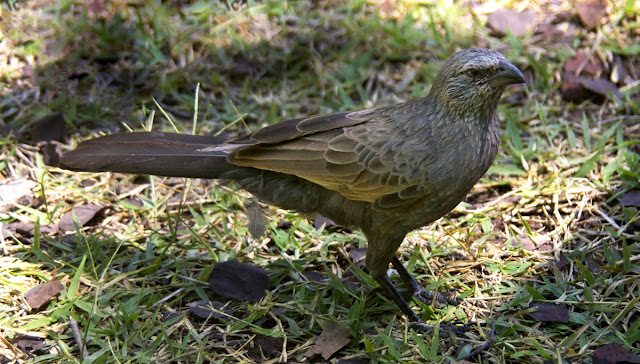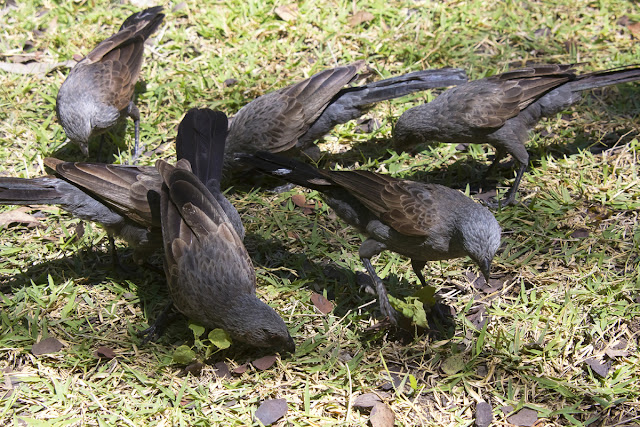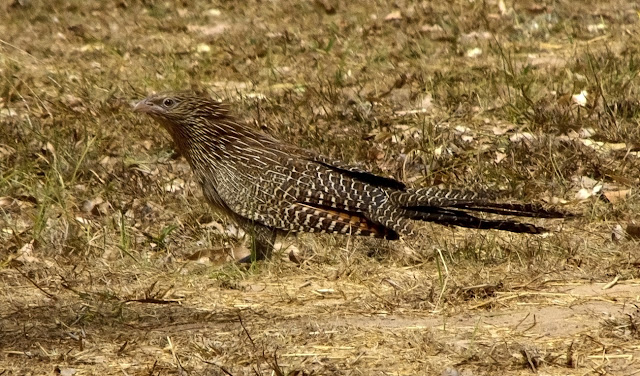White -necked heron. Innaminka
This is a black-necked strork, taken at Fogg Dam, through a smokey haze from all the bushfires in the area at the time. It has caught this cat fish. They use their huge beaks and repeatedly jab at what they eat. They are also called jabirus, which even though sounds like it is an aboriginal word, it apparantly is a slang name given to them in modern times

White-necked heron
Ducks swimming down what is often nothing more than a trickle- if it is flowing at all. Taken in part of the Cooper Creek catchment area. The ducks are hardheads or white-eyed ducks.
Ducks swimming down what is often nothing more than a trickle- if it is flowing at all. Taken in part of the Cooper Creek catchment area. The ducks are hardheads or white-eyed ducks.
A darter drying its wings. Cooper Creek.
Once we reached the coast we were back to seeing more maring birds like this Crested Tern.
This is a honeyeater..a Yellow-plumed Honeyeater I think. It is taken on the coast of SA on the way home.
The next few shots are of birds known as Apostle birds. They are always part of a group and they usually have about 12 family members, hence the name.
This is a Nankeen Kestrel. They are found all across Australia.
Black Kite
These cormorants are perfectly designed for their fish diet. There beak has a hook on it which allow it to hold on to the struggling prey, like this large catfish. It swam around with the wish like this for minutes, presumably so it the fish would be dead and it would be able to swallow it more easily.
It is a Pied Cormorant.
This next shot is a Pheasant Coucal. They are rather comical and clumsy birds. They have striking markings only obvious really when they are on the ground like this. They would rather clamber through tree branches than fly.
All of the following photos are taken in NT, in and around wetalands, towards the end of the dry season (Aug/Sep).
These are Wandering Whistling Ducks and a Magpie Goose taken on a billabong near Kakadu NP.
Darter. These are sometimes called snake birds becuse of the way their neck can move. It almost looks unnatural.
This little member of the parrot family is known as a cockatiel.
These are galahs, another memebr of the parrot family. They are found nearly every where in Australia, sometimes in huge numbers. They are common everywhere except in the driest parts of the country.
Darters dryings their wings after fishing. When they swim on the surface their whole body is often emerged with just the head sticking out... They dissappear quicly and silently into the water. Their feathers do not hold the air in them like most other water birds.
Cormorant and a Darter, Darters and cormarants look fairly similar but the darters have a straight beak with no hook, so good for spearing and jabbing, where as the cormorants beak, with a hook on the end allows it to grab and hold on easier.
Intermediate Egret ?.
This is a Little Egret, taken through smokey haze at Fogg Dam.
Nankeen Kestral.
The next two photos are of jacanas at Fogg Dam. Their really long toes let them walk arcross the tops of the lily pads.
These are Magpie Geese.
The bumb on the top of the head gets larger as they get older.
Masked Lapwing, also known as a spur-winged plover.
Pied Cormorant.
Little Black Cormorant, up close these birds have really pretty blue-greeen eyes. They often are in flocks and hunt fish together with pelicans.
white-necked heron with its dinner.
White-necked Heron
Bee-eaters,
Black-Tailed Native Hen. These guys need to nake a good running start so they can take off in flight. They would prefer to walk or run.
The next couple of photos are of grebes, taken at the Coorong, SA There was a huge flock of thousands of them, There were mainly Hoary-Headed Grebes, but also a few Great Created Grebes with breeding colours(not any in these shots --sorry)
Welcome Swallow
I think this is a Rufous Whistler. They are a nomadic bird found in most parts of the country.
This is a type of crested hawk, known as Pacific Bazza.



























































